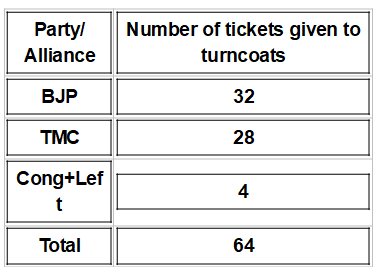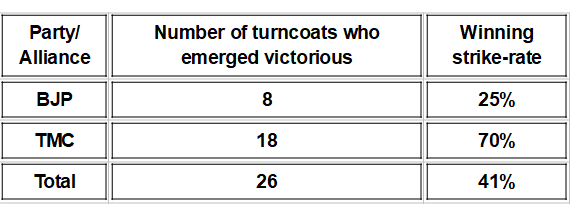West Bengal Polls: BJP's Potent Defection Formula Misfires

Representational Image. Image Courtesy: Sunday Guardian
The expansion of the Bharatiya Janata Party (BJP) beyond the Hindi heartland after its victory in the 2014 Lok Sabha Elections, and its electoral victories in assembly polls in the unlikeliest of places, has been extensively discussed and analysed by political pundits in the last few years. While pundits may differ on a few points, few commentators or analysts will contest the argument that engineering defections has been a key component of the saffron party’s expansion plans. The BJP has been ruthlessly practical and not shied away from co-opting political heavyweights from rival camps. Many leaders who built their political capital by taking a strident anti-BJP stance are today mascots of the party in their respective states. With Himanta Biswa Sarma, Okram Ibobi Singh and Pema Khandu the BJP has three CMs who cut their political teeth in the Congress.
Over the years, the BJP has mastered, patented and employed the strategy of engineering defections across the country. Buoyed by the success of its strategy in different states, the BJP invested heavily in turncoats in the high-stakes West Bengal assembly polls. In the months leading up to the elections, the BJP had roped in several senior TMC (All India Trinamool Congress) leaders, lawmakers and former close aides of Chief Minister Mamata Banerjee. Amidst much fanfare and media attention, some of the TMC turncoats had joined the party after being flown into New Delhi in chartered flights.
A cursory glance at the constituency-wise election results reveals that turncoats (those who contested the 2016 polls on TMC, CPI, CPM, Congress tickets) fielded by the BJP in general, and the TMC-turned-BJP candidates in particular, fared poorly. Almost half of the turncoats who contested the 2021 elections (32 out of 64) belonged to the BJP; only eight of them emerged victorious. The turncoats who jumped ship from the TMC to join the BJP fared the worst – four out of 18 such BJP candidates could manage to win. On the contrary, the turncoats who contested on TMC tickets – most of these candidates had switched to the TMC from the Congress or the Left – did comparatively better, managing a strike-rate of almost 70%.
Table ‘A’- Number of turncoats fielded by major parties/alliances in 2021 Bengal assembly polls.
(Note: The term turncoat implies candidates who contested the previous assembly election on another party's ticket. BJP turncoats include candidates who contested the previous assembly poll on TMC, Congress, CPI, CPM tickets.)

Source: 'Lokdhaba'- a platform of Ashoka University.
Table ‘B’- Winning strike-rate of TMC and BJP turncoats in 2021 Bengal assembly polls.

Source: 'Lokdhaba'- a platform of Ashoka University.
Bengal, Never A Happy Hunting Ground For Turncoats
While the mass exodus of TMC leaders to the BJP was being seen as a sign of the nose-diving prospects of the former and the rise of the latter on Bengal’s political horizon by hopeful BJP leaders, sympathisers and by even a section of the press, these assumptions were probably discounting the performance of turncoat candidates in previous assembly elections in Bengal. Between 2001 to 2016, in four assembly elections, 198 turncoats contested assembly elections from various parties and only 67 of them managed to win. The strike-rate for turncoat candidates before 2021 in assembly polls (held post the turn of the millennium) was a measly 33%.
Several Heavyweights Bite The Dust
In the months preceding the Bengal elections, over two dozen TMC lawmakers and several disgruntled leaders of the party had switched to the BJP. While the numbers make it clear that turncoats who switched from Mamata's party to the BJP performed dismally, a closer look at constituency-wise results throws up a few surprises. Many high-profile defectors who were expected to bring in seats for the BJP in their districts or pockets of influence failed to win even their own seats.
Prominent TMC turncoats including former state minister Rajib Banerjee, former Singur MLA Rabindranath Bhattacharya and former Bidhannagar mayor Sabyasachi Dutta face defeats. While Suvendu Adhikari managed to defeat the CM in Nandigram, he could not deliver the district of Purba Medinipur – considered to be an Adhikari family bastion – for his new party. The TMC won nine of the 16 seats on offer in the district.
A statistical analysis of the individual performance of BJP’s imports from the TMC, their dismal strike-rate, or failure to win seats in their pockets of influence, does not fully assess the damage suffered by the BJP by its over-reliance on the strategy of engineering defections. Data from various pre-poll surveys and ground reports by journalists had hinted at an alarming level of anti-incumbency against the incumbent TMC government. By launching an aggressive pre-poll defection drive targeting senior TMC leaders and close aides of Mamata Banerjee, the BJP committed a self goal. From being seen as a whimsical leader with a highly autocratic style of functioning battling heavy anti-incumbency, Mamata was – as a consequence of the BJP's defection drive – now being seen as the proverbial ‘underdog’ who was up against the entire might of the Central Government, the colossal election machinery of the BJP and a bevy of TMC imports. Not one to miss an opportunity, Mamata and the TMC cashed in, accusing the turncoats of being ‘traitors’ or ‘back-stabbers’.
The induction of outsiders from the TMC and other parties also exacerbated the inner party conflict within the Bengal BJP. Several BJP leaders and karyakartas were left seething after the party rolled out the red carpet for ‘outsiders’ and gifted them tickets. The disgruntlement among the rank and file among the party was quite visible throughout the election. In several seats, the party was even forced to change its candidates. As high-profile turncoats like the Narada sting and Sarada scam accused troika of Suvendu Adhikari, Shovan Chatterjee and Mukul Roy were accommodated in key leadership positions, the BJP, which kept on promising ‘Asol Poriborton’, ended up looking like a ‘Trinamool B’ team. The lack of local leadership and bench-strength in the state was badly exposed.
The strategy of engineering defections has been undoubtedly one of the most potent weapons in the BJP’s arsenal in recent times. It has enabled the party to win elections in states like Manipur, Tripura, etc where it barely had any ground presence and helped it capture power through the backdoor in states like Goa, Madhya Pradesh and Karnataka. But the Bengal experience is a rude reminder for the BJP; a ‘one-size fits all’ approach simply does not work in the diverse electoral landscape of India. What works in Madhya Pradesh, Gujarat or Goa may not necessarily work in Bengal. To make matters worse for the BJP, there are murmurs of several TMC turncoats trying to return to their parent party. Will the BJP get a bitter taste of its own medicine in Bengal? Only time will tell.
The author is a freelancer based in Bombay and an alumnus of Mumbai’s St. Xavier’s College. His interests vary from politics, psephology, and journalism to regional Indian cinema. He tweets @Omkarismunlimit
Get the latest reports & analysis with people's perspective on Protests, movements & deep analytical videos, discussions of the current affairs in your Telegram app. Subscribe to NewsClick's Telegram channel & get Real-Time updates on stories, as they get published on our website.























